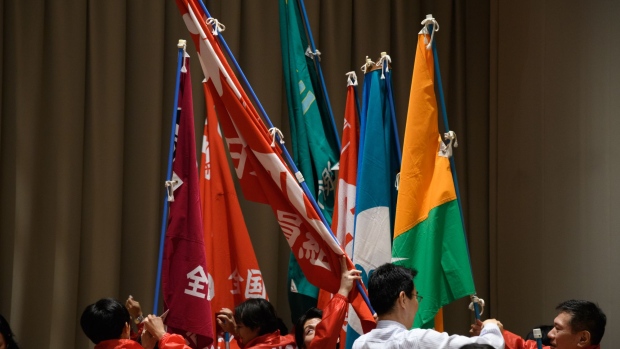Feb 21, 2023
Investors Watch Japan’s Spring Wage Talks for Clues on BOJ Moves
, Bloomberg News

(Bloomberg) -- For more than half a century, Japan’s corporate giants have held annual negotiations with labor unions to decide pay increases for the year ahead. Never have those talks meant so much to so many beyond the workers themselves.
This year, the outcome matters to bond investors, stock traders and anyone, really, with anything at stake in the country. That’s because wage growth will continue to be a key factor for the Bank of Japan’s policy under Kazuo Ueda, who is expected to replace Haruhiko Kuroda as governor in April. Kuroda made 3% wage growth a precondition to ending years of ultra-easy monetary policy.
And when that happens, it’s likely to have a major impact on markets, companies and the economy itself.
Unions file wage demands to firms every February in an annual wage negotiation known as the shunto, or “spring offensive.” After weeks of talks, large companies typically announce their decisions around mid-March, followed by smaller firms before the start of the financial year on April 1.
Goldman Sachs Group Inc. predicts an average pay hike of 2.8% this year, which would be the highest since 1997. But that’s still short of the 3% level that Kuroda says is necessary to tighten monetary policy.
“Wage increases are gaining momentum across the board” with inflation and labor shortages, said Hisashi Yamada, vice chair of Japan Research Institute Ltd. “The BOJ will likely wait and see if these hikes will continue beyond this year, before deciding on whether to hammer out a full-fledged new framework toward policy normalization.”
The BOJ has carried out an unprecedented campaign of negative interest rates, massive bond-buying and yield-curve control in an attempt to stimulate the economy and spur higher prices and wages. Kuroda has repeatedly said 3% pay growth is needed to show inflation is sustainable.
Experts say shunto began in 1955 after mass layoffs during an economic slump. As the economy entered its high-growth period in the following decades, unions had the upper hand and strikes were common. But that all changed when the bubble burst in the early 1990s, and these days unions are much less combative.
Japan’s average wage is the lowest among the Group of Seven nations and has been almost flat for the past three decades.
Prime Minister Fumio Kishida has been putting pressure on companies to increase pay, aiming to create a cycle of growth and wealth distribution. The premier said last month he would push firms to give raises that exceed the inflation rate, which has hit the highest since 1981.
There are some signs of progress. Japanese workers’ nominal wages rose 4.8% in December from a year earlier, the fastest pace since 1997. That was partly helped by hefty increases in winter bonuses. Uniqlo clothing brand owner Fast Retailing Co. plans to raise annual pay for full-time employees in Japan by as much as 40%. Nintendo Co. said it will increase salaries by 10%.
And there are signals more is on the way. The Japanese Trade Union Confederation, which is known as Rengo and is the largest umbrella organization of labor unions, demanded increases of about 5% this year, the biggest hike request in 28 years. Toyota Motor Corp.’s union called for its largest increase in two decades, which the company agreed to at the first round of negotiations. Honda Motor Co. followed with the steepest base pay rise in about 30 years.
Rengo typically puts together a guideline for negotiations before the end of the year. Industry unions then decide their demands by mid-February, followed the unions of large companies. Then the wage negotiations kick off.
Should wages continue to rise and exceed the BOJ’s inflation goal, leading the central bank to tighten policy, the impact will be felt across global markets. Even a modest tweak to the BOJ’s ceiling for the 10-year bond in December triggered volatility in yields and the yen, sent Treasuries lower and moved everything from US equity futures to the Australian dollar and gold.
But it’s still far from certain. Questions remain about whether the headline-grabbing moves at blue-chip firms will be replicated in the many smaller companies that employ 70% of Japan’s workforce. Remember, many of these workers aren’t even in a union: The proportion of unionized workers fell to a record low of 16.5% last year, according to the Japan Center for Economic Research, a think tank.
And smaller companies face bigger hurdles to raising pay, such as high energy and materials costs and weak profits, according to Toru Ishida, president of the Japan Chamber of Commerce & Industry, a business lobby that represents small and medium enterprises. Many smaller suppliers have been unable to pass on the increased costs to big customers who refuse to negotiate on prices.
Ishida said more must be done to support smaller firms so they can boost profits and pay employees more.
So while there’s increasing interest in this year’s shunto negotiations, there’s also pessimism in the air.
“It’s a very tough phase for small and medium-sized firms,” Ishida said. “They are under pressure to increase wages but they don’t have much funds.”
(Adds Toyota and Honda’s pay increase in 12th paragraph)
©2023 Bloomberg L.P.






